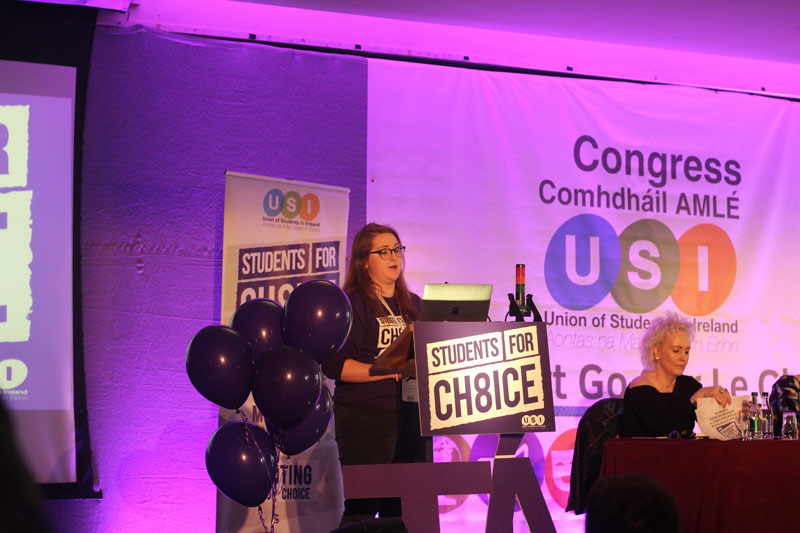Síona Cahill is no stranger to advocacy. It was Cahill who, while still a relative novice in Maynooth Students’ Union (MSU), came up with the much-used #MakeGráTheLaw, pitching it to the Union of Students in Ireland (USI) President Laura Harmon.
From there she has gone on to use her platform both in MSU and in USI as two-time vice-president for equality and citizenship to represent and advocate for women, LGBT students, mature students and disabled students. Her contributions to the campaign for marriage equality earned her the title of equality activist of the year from USI.
If Cahill is a trailblazer, she isn’t one to talk about herself. She would rather discuss the issues. Indeed, she insists that “USI is about much more than who is leading it” and is keen to voice her distaste for any sort of “cult of personality” in student leaders.
Cahill had somewhat of an unlikely start in student politics. Like many students involved in campus societies and activism, she was unsure what the union could offer her. In hindsight, she wishes she had “used the resources of having the structure and the lobbying power” sooner.
She has not been “ambitious within the USI structures”, she says, and had no intention of running for president when she joined officer board two years ago.
Our conversation quickly turned towards Take Back Trinity. Cahill was impressed at its ability to draw students from beyond the students’ union and she’s determined to do the same with USI and “break down” perceptions of students’ unions.
It’s an uphill battle every year for the national union to reach out to its membership directly, but it’s something in which Cahill has had success in her campaign work, putting it down to “getting people in the room together”. Known for her social media smarts and her ability to mobilise students – ahead of the 2015 marriage equality referendum, she registered 4,500 of Maynooth University’s 14,000 students – perhaps Cahill can bring increased engagement to a union that has battled a plethora of membership referendums in recent years.
Speaking year after year about the urgency of the higher education funding crisis, candidates for USI have a tendency to sound like a broken record. Cahill writes extensively in her manifesto about her wishes to “reignite the fight”. It’s one that needs a desperate fix. Politicians have largely ignored the issues for months, while even students’ union enthusiasm for the issue has dimmed. Yet, like her predecessors, she thinks lobbying is always going to be crucial.
“We aren’t flowing out on the street every week about higher education funding but that doesn’t mean that the work isn’t ongoing”, she says. And she points to USI’s achievements in challenging the “presumption that income-contingent loan schemes would be the option that we would go with”, which she says has been achieved through building relationships with policymakers and politicians – something that doesn’t happen publicly and which, according to Cahill, is is overlooked in people’s assessment of USI’s success.
With Take Back Trinity causing a commotion that received much national attention, the impact that students can have on higher education funding is evident. “I don’t think people aren’t interested. I think people maybe don’t see the urgency.”
But higher education funding isn’t the only issue facing unions. Securing students’ union autonomy, in the face of prying colleges and universities, has been something that USI has been trying to push, with little tangible success thus far.
Cahill says “we need to do more for union development, supporting students’ union executives to strengthen their autonomy, their structures and their governance” and points to lobbying on a national level for a national student partnership agreement as a potential breakthrough in the foreseeable future. “It’s something that doesn’t happen in one year”, she says, but efforts will have to be sustained to put this on the agenda.
In recent years, USI has seen Harmon and former President Annie Hoey, two formidable women who seem most comfortable when behind a megaphone, take the helm of the organisation and Cahill seems to be trailing them, having like them spent two years in the role of vice-president for equality and citizenship.
She has played a key role this year in the fight for gender equality in students’ union positions, spearheading the organisation of the large-scale Women Lead campaign. As Harmon and Hoey continue to work for women’s rights nationally, much will be expected of Cahill in this area.
For her, gender equality in students’ unions can’t be ignored: “We are not in a strong position to be critical of institutions or society if we are not taking action ourselves internally.”
But with her emphasis on advocating for others and empowering students from all backgrounds, she hopes that some headway has been made and will be made under her leadership.
On a busy Bank Holiday weekend, Cahill is still busy. But before she goes, she reiterates how important it is to be an advocate for “marginalised students or students who are finding it difficult to access or succeed in the system”.
“I am so committed to this and I give a shit, to be frank, and I think that has been the mark of the best presidents.” Long hours, uphill battles and an unprecedented higher education funding crisis: “I live for it.”







